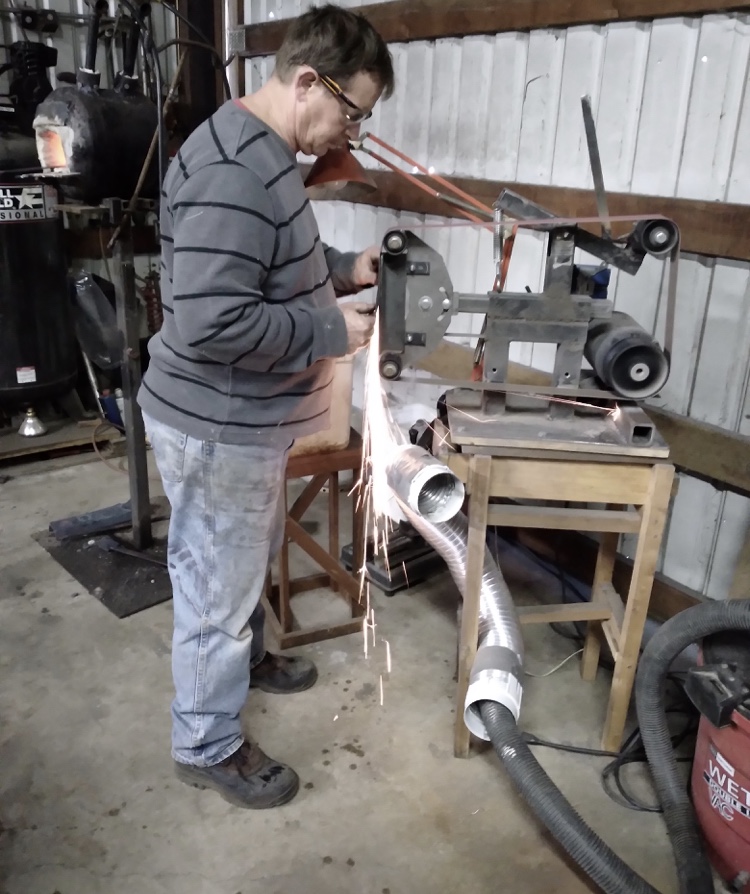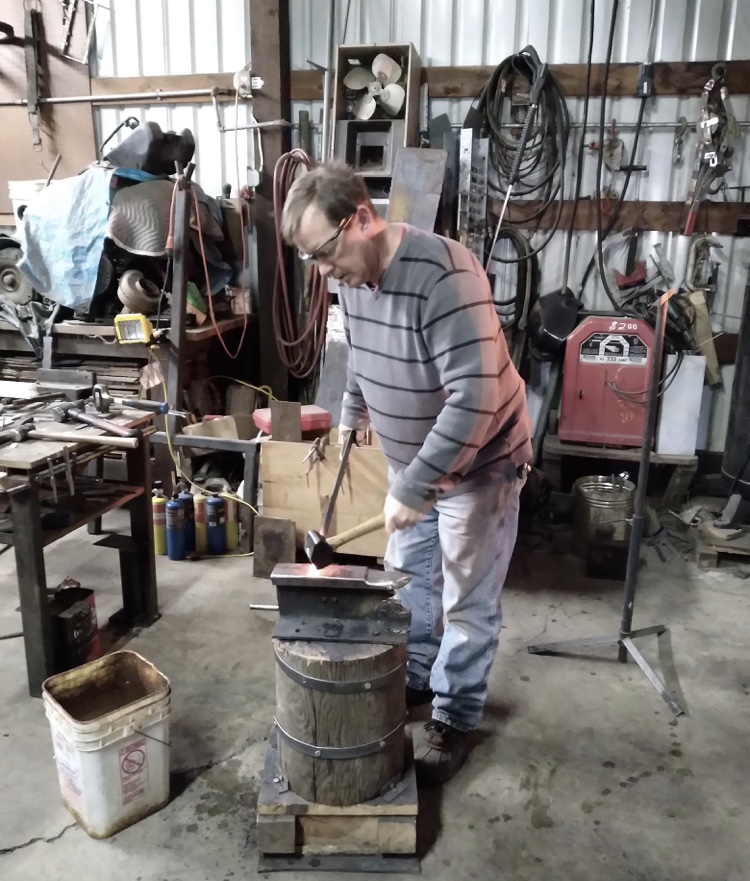I’ve been using a Iron Thistle Forge Chefs Knife. There is just no comparison between these great custom made carbon steel knives and the stainless steel knives I’ve used in the past. I highly recommend checking out Iron Thistle Knives. Contact information is at the bottom of this post.
Meet knife maker Tim Moyer.
What drove me to becoming a knife maker.
I have long had a fascination with the craftsmanship of blade smiths such as Steve Scwarzer, Bob Loveless, Jason Knight, Burt Foster etc. and the process of forging a knife vs. a stamp cut or ground to shape production knife.
So, I began studying and became an idealist in nature. I had all this research on forges, grinders, steel etc. but never put into practice. Then after watching a lot of videos of makers, Master Smith Jason Knight finally hit it home, Just do it. So it began.
I am heavily involved in our local Scottish society and thought, ” Hey I can make a Sgian Dubh”, its small, relatively simple design, should be piece of cake. Boy was I ever wrong. But, after many trials and errors and my scrap knife bucket getting fuller and fuller, I took a class with a man I admire greatly, Master smith Jason Knight.
I have since studied more under his teachings and grew leaps and bounds with that knowledge, as well as knowledge of peers locally in what we call “hammer ins” where makers get together, to work together and share tips and tricks.
So began my journey into knives of Celtic origins. I do specialize in those type blades, from Sgian Dubhs ( skeene doo) to Scottish dirks and even made a couple iron age celtic ring hilt knives.
I also worked up into some hunting and field knives and developed my style, incorporating some celtic influence into them.
Then came the big jump, into kitchen knives. Its fascinating learning the difference between a chef style knife vs. a general kitchen knife.
But, as for my process, I hand forge all my knives from blanks of high carbon steel bars. Be it flat bars or round bars, using a forge, hammer and press to manipulate the steel into desired shape, length and edge geometry .
Why carbon steel and not stainless? Well, that’s a long story on metallurgy and differences etc.
But carbon steel can be forged, stainless cannot ( now, there are some caveats to this, that again would require much explanation on metallurgy). See Below.
So going on about 2 years, I am enjoying it immensely and is definitely a passion and enjoy learning everyday and improving . That will never stop.
While my passion is still in celtic origin knives, kitchen knives are a second. The challenge of getting that edge geometry just right so its not just a knife shaped object, but a working, functioning knife that someone is likely to use every day vs. a knife maybe used occasionally if ever is rewarding as well as frustrating at times.
High Carbon Steel
Pros:
Great edge retention- Holds a sharp edge much longer than stainless .
Durability
High carbon steel is harder and stronger than stainless
Sharpening
Easier to sharpen
Cons:
Can chip if used against a hard surface.
Will rust if not properly cared for.
Stainless Steel
Pros:
Rust resistance
Better resistance to corrosion due to high chromium content.
Less expensive to produce
Most, certainly not all, knives made by “stock removal” use stainless as it does not lose its temper under high heat that comes with extended grinding periods.
Cons:
Durability:
Softer than high carbon steel, it doesn’t hold a cutting edge as long and requires sharpening multiple times
Sharpening:
Because it’s a softer steel, it’s also harder to sharpen and easier to damage during the process.
Products
Forged knives vs stock removal and production knives.
Simply put, a forged knife is done manipulating a piece of steel under high heat ( 1800 + F ) and a hammer to move the steel into shape. The initial edge is also forged into the blade.
Grinding refines the shape, removes scale and adds the final cutting edge.
This gives each knife its own unique shape, that while may be similar to another, no two will be exactly alike.
Stock removal
A flat bar of steel is cut to a rough shape, grinder is used to shape it as well as add the initial edge bevels and cutting edge. Much easier to recreate knives in a pattern that will be alike. Faster and usually cheaper way to make a knife.
Production knives
Steel is stamp cut or water jet cut and edge bevels ground in. This is how you get store bought knives. Easier to do multiple blades in a short amount of time.
Each have their merits and makers of either style make some fantastic blades.
Forging is “old school” like you see in movies and makers trend to embrace the “classic” way of knife and sword making.
Stock removal is great for quicker and “easier” way of making a knife. Using high carbon steel, the end result is same as a forged knife in way of durability and edge retention.
Production knives are typically the knives you find being mass produced and sold in stores. They are made and finished using all machinery from start to finish.
Iron Thistle Knives is now taking custom orders. If there is something you have always wanted from a custom maker at ,an affordable price contact Tim. He’s happy to provide what you want, be it Celtic Blades t Kitchen




